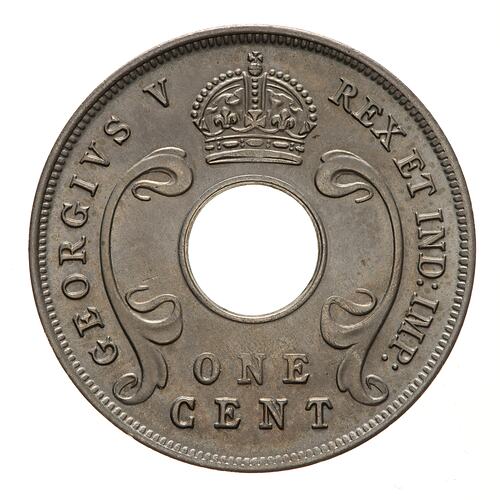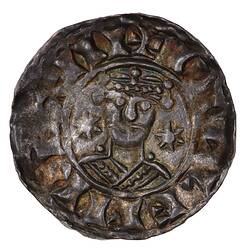Summary
1 Cent, Issued by, British Colony of East Africa (Kenya), 1921
Minted by Royal Mint, London
Not released for circulation
Obverse Description
A central hole with curved floral design to left and right; above hole, crown; below hole in two lines, ONE / CENT; around, GEORGIVS V REX ET IMP: IND:
Reverse Description
Curved around central hole four elephant tusks; above hole, 1; around outside line circle, EAST AFRICA 1921
Edge Description
Plain
Significance
The rupee of British India had come to be the coinage standard of the Protectorate of East Africa and Uganda (largely because it was used to pay Indian workers on the Kenya-Uganda Railway). In 1920 the East African Protectorate became the Colony of Kenya, the East Africa Currency Board was set up in December 1919. It introduced a new decimal system based on 100 cents to one East African Florin in 1920 (this coin), abandoning yet retaining the old rupee system - the florin being the same weight as the Indian rupee. This was very short lived, on 1 May 1921 it was replaced by a system based on 100 cents to 1 East African Shilling. This system was expanded on 1 January 1922 to be the official Currency of Kenya, Uganda and Tanganyka. This 1 cent coin was prepared under the florin based decimal system of 1920; the issue was not required as the new shilling based system of 1921 was to have a bronze 1 cent coin (first issued 1922).
More Information
-
Collecting Areas
-
Acquisition Information
Transfer from Melbourne Branch of Royal Mint, 11 Jan 1978
-
Date Issued
1921 AD
-
Issued By
East African Currency Board, British East Africa (Kenya), 1921
-
Mint
-
Denomination
-
Material
Copper-Nickel
-
Axis
12
-
Classification
-
Category
-
Discipline
-
Type of item
-
Dimensions
22 mm (Outside Diameter), 2.892 g (Weight)
-
Shape
Round with round hole
-
References
KM#12 Remick, Jerome Guidebook & Catalogue of British Commonwealth Coins, p. 159-165 [Link 1] (Central Bank of Kenya - History of Kenyan Currency) 51st & 52nd Annual Report of the Deputy Master and Comptroller of the Royal Mint, 1920 & 1921, p.15
[Book] Bruce, Colin R. 2009. 2009 Standard Catalogue of World Coins 1901 - 2000.
-
Keywords






